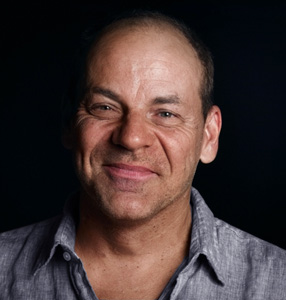Disclaimer: This past year I consulted for the League School of Greater Boston, the school that is the subject of this piece. I worked with their students on a self-advocacy curriculum, and I’ve also presented for the school on separate occasions. Seeing what they are attempting up close demanded an article.
***
The meeting of administrative leaders was almost to a close. For 90 minutes, these colleagues had been sharing the myriad of changes they’d seen over the past decade, when the League School of Greater Boston was starting to shift its approaches to “behavior,” even as a concept. While always an eclectic mix of approaches, the school was committing more and more to SCERTS, and using ABA less like a blueprint, and more like a supplement. But change is hard, and so amidst the overall victories, it was also imperative to reflect on the toll that this transition was taking on them.
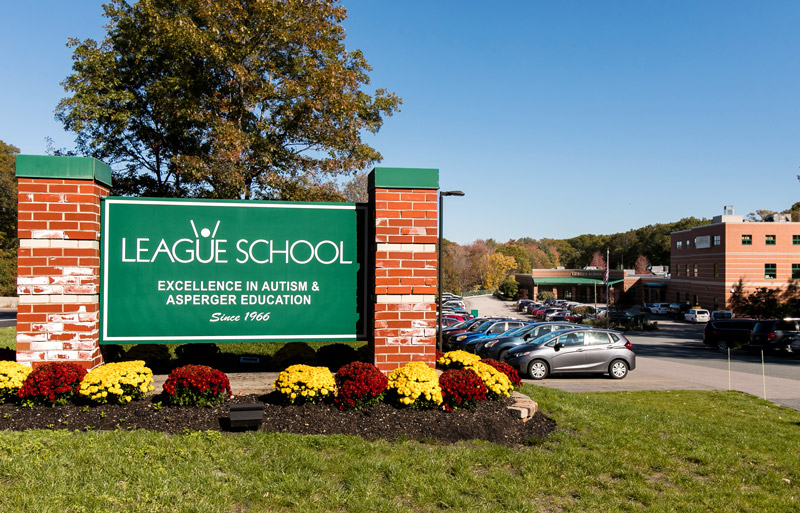
The League School of Greater Boston
Educational Director, Patrick Fuller, a 30-year veteran of special education, had remained mostly silent through most of the meeting. And for this very reason, towards the end, Fuller was then somewhat ambushed, and asked for his thoughts.
He recalled the period that began around 2015 – one that continues today – when on the well-known job site Indeed.com, former teachers began posting negative reviews about the school. Many in the room nodded, acknowledging that those still visible opinions would serve as permanent reminders of the aforementioned toll. It summoned memories of people they’d worked with, who despite whatever animosity may have resonated over the school’s ideological changes…these were once, real relationships they had with fellow humans, that had ended painfully.
Fuller’s experience added some perspective.
“Some of the things I was taught (in how to educate autistic students) were just horrific. ‘Drill and kill’,” Fuller remembered, appreciating the school’s ongoing transition to a more humanistic system. “It’s not just in terms of ABA. It’s in terms of everything we do…I’m really excited by this group, and seeing where we can go.”
***
The League School of Greater Boston is situated in Walpole, Massachusetts, close to the Rhode Island border off both I-95 and I-495. It contains many of the demographic similarities of other traditional autism schools, such as serving a wide range of autistic abilities in its enrollment (usually a little over 100 students). This varies from numerous non-speaking autistics to very verbal students whose challenges are mainly rooted in emotional regulation. The age range is full (3-22 years old) and the school has a long-established residential wing. Most admissions are paid for by the state and down the road, expansion will almost certainly become a necessity.
Traditional autism schools, historically, have had their philosophies rooted in the use of Applied Behavioral Analysis (ABA), the longstanding strategy for correcting behavior in autistic people. However, the League School always kept their options open. To some during ABA’s heyday, the League School’s openness seemed vague, uncommitted, even “intellectually sloppy.” But as they have shifted more towards Social Communication Emotional Regulation Transactional Supports (SCERTS), ABA’s figurative monopoly on overall autism treatment has, coincidentally, been steadily decreasing as the practice continues to undergo a very painful reckoning. Not only has ABA been linked to intensive trauma (especially through the practice’s “Discrete Trials” component), but newer educational techniques have emerged that are rooted in more humane implementation. SCERTS is one such newcomer. And while the job is by no means finished, the League School has been painfully changing itself in incremental steps. Lindsay Thelin Wagner was once an Occupational Therapist (OT) at the school, and is now their Director of Neurodiversity and Community Inclusion. They have brought in autistics to teach autistics. And they now liken themselves to a full-on SCERTS school, one of few in the country.
But the League School’s transition, in addition to being painful, has also not been so simple. For starters, they do not fully discard ABA, citing SCERTS’s multi-disciplinary design (of which certain aspects of ABA can theoretically be a component). And the humanism that defines the principles of SCERTS is by no means a new concept with which the school is unfamiliar.
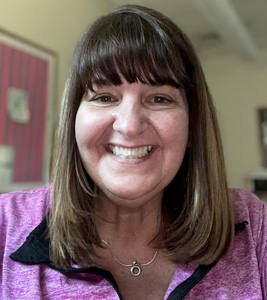
Carla Dyer
Carla Dyer has been teaching at the League School since 2000.
“I really didn’t do much ABA. But other rooms did Discrete Trials, the same task over and over…The SCERTS model was sort of what I’ve sort of been doing all along.”
Many teachers, not just Dyer, emphasized that because of the focus on emotional health, SCERTS techniques have been historically implemented even when teachers didn’t have a name for them. Dyer, referring to her manner of refuting ABA’s compliance-based ideas, cited one example…
“I had a student recently who just wanted to shut down. I try to teach them, ‘You can just tell me that you need a break, or hold up a card that means you need a break.’ I’m trying to give them a voice that says ‘I’m not ready to learn right now.’”
Lana Falvey, a speech and language pathologist (SLP), and Tracey Mello, an OT, have been teaching together (minus a good-sized maternity leave for Falvey) since 2011. They too remember how diverse the school was in its use of behavioral strategies.
“There was a lot more butting of heads around here, like ten years ago when our behavior department was disagreeing pretty consistently with speech and OT.” Falvey remembers.
Mello concurs: “There’s been a big effect from the SCERTS model.”

(L-R) Lana Falvey and Tracey Mello
Surprisingly, the behavioral practices employed by autism schools are often not centralized. The overarching philosophies can differ classroom by classroom, and this is where cultural divisions can originate and grow in such schools. Unfortunately, Behaviorists (usually rooted in ABA) arguing with speech and OT professionals are a common staple of life inside most autism schools.
In response, one would think that the solution lies in managing the expectations of new staff during the onboarding process. If so, then what challenges exist for the training directors charged with this process?
Deborah Torres is the school’s Manager of Training and Quality Assurance, and Leslie Haney is the Teacher Trainer and Mentor. They cited that since it is so easy to get 40 hours per week of ABA covered by insurance (try getting even 5 hours per week of SCERTS, or other developmentally-based alternatives), that the job market has exploded over the last decade with opportunities for new ABA technicians.
But somewhat ethically-challenged recruiters on LinkedIn almost never share knowledge of the practice’s rapidly-growing infamy. And this results in a future moment of sadness mixed with disappointment for the well-meaning young people who enter the field, as these are almost always earnest folks who did not enlist because they “wanted to hurt autistic children.”
Haney: “I think it’s hard to find teachers that have special education and behavioral backgrounds who have zero ABA experience but still have experience with our (autistic) population.”
Before switching to a training focus, Torres herself had a strong ABA background, but is immensely excited by the changes she sees. She talked about the joys of seeing an ABA-experienced new hire somewhat converted by the SCERTS training that is now a mandatory part of their onboarding procedures.
“For the new hires? (Our onboarding curriculum is) something that we’ve changed significantly.” Torres smiled. “And that SCERTS training?…they love. Seeing the passion…”
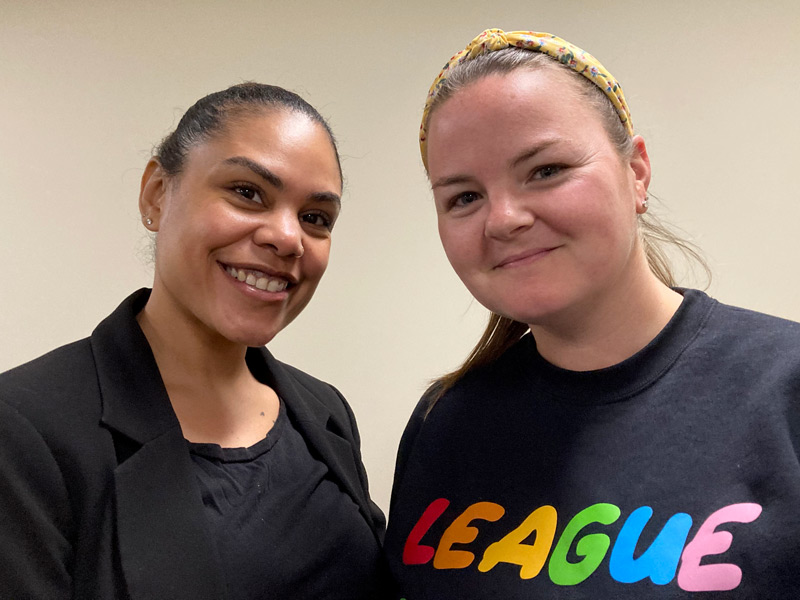
(L-R) Deborah Torres and Leslie Haney
To be fair, the truly torturous aspects of ABA are rarely seen anymore. Certainly no one slaps children as its founder, Ivar Lovaas, was known to do (Lovaas, by the way, is also the author of “Gay Conversion Therapy”). The painful eradication of self-regulatory stimming is becoming less frequent, eye contact is less mandated – frankly, knowledge about what all self-regulating behavior does to a person (i.e., it helps them) is being increasingly respected.
But discrete trials still exist. In a discrete trial, for instance, a clinician might spend that 40 hours with a (we’ll assume) non-speaking autistic who flaps their hands as a self-regulating behavior they use to feel good in a confusing world. Well, now imagine the clinician grabbing those hands and shoving them into your lap for 40 hours a week, over years maybe? And you have no idea why they’re doing this to you…
In principle, ABA has historically been about making a person with autism look and behave less autistic. ABA’s implementation has been centered in compliance, not concerning itself with the “why” a student might act differently than a neurotypical. Behaviorists in general have historically avoided even asking the “why.” And ABA’s greatest allies have historically been parents, who did not know of the long-term damage that ABA might be causing. ABA changed the “offending behavior” faster than others, and you couldn’t beat the cost.
But more and more parents are becoming educated about the psychological, emotional, and traumatic costs. And instead, they are increasingly requesting strategies that preserve their children’s sense of self. More and more are enrolling their children in the League School for the very reason, and not despite the fact, that the League School is using ABA less.
Again, though; it’s complicated.
***
Michaela Fanelli is one of three Assistant Directors of Education under Fuller. She’s also a BCBA (Board Certified Behavioral Analyst – the certification of the professional authorized to implement ABA). But before that she was a regular classroom teacher.
“I had this one student who, to this day, has my heart. He identifies as neurodivergent. He was very gifted academically, but he had a lot of challenges with the social piece, and that brought on a lot of challenging behavior.”
She didn’t even know what a BCBA was but wanted to help. “And so this woman (at the school) just gave me this data sheet and said, ‘Good luck.’ She didn’t really give me anything. I didn’t know what I was doing. But all I knew was that I needed to help this child.”
She Googled what a BCBA was, read up on ABA, consulted others, and read about behavior plans “that basically said, ‘Give the kid a sticker, and send them on their way.’”
“It doesn’t do anything. The sticker was meaningless. But I still created this plan for this one particular child. He loved it, and just had so many more successes each day…He’s in public school today, and he’s doing great.” Fanelli then got her BCBA certification.
Fanelli acknowledges that in her case, the student clearly wanted the work that she was doing with him. He wanted a social life, and Fanelli was his only hope at that school. Fanelli stresses she wouldn’t work with anyone otherwise. Though not all BCBAs share her priorities, she stresses that these days, most do. Fanelli, like so many, was unaware of the controversies when she entered the field, and now acknowledges the mistakes of the past. But when she examined her situation, she remains convinced that those harmful techniques/priorities had nothing to do with what she was personally doing with kids. She wants the practice renamed, “Progressive ABA.”
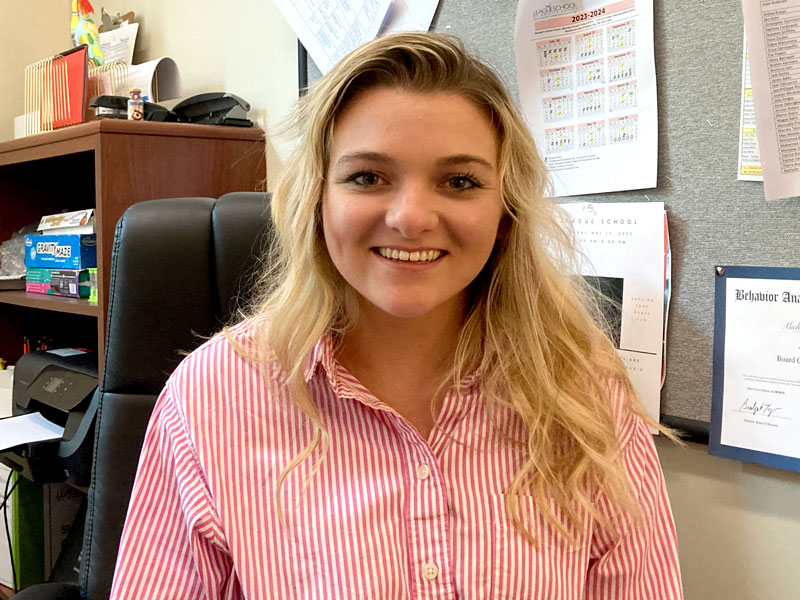
Michaela Fanelli
“When I was first in (BCBA) school, they gave us strategies for getting the student to make eye contact…And I promise you, I have never taught an individual to do eye contact…if a student is engaging in self-stimulatory behaviors. I mean, who the hell cares?”
Cheryl White is the League School’s COO. “I don’t know if we’re moving away from ABA. Because I think it’s a piece. I think it’s more about refining what we do. It’s not about ‘We don’t do this, we do this.’ I’ve liked the idea of an adjustable toolbox for years , and not everybody’s is the same…I think our advantage is going to be having everything available to us.”
***
Dr. Barry Prizant is the author of the iconic book, “Uniquely Human: A Different Way of Seeing Autism,” and is also one of the SCERTS authors. He could relate to how tough a transition this might be for a school like the League School. He acknowledges that traditional ABA (that practices discrete trials) has done incredible harm – he’s no fan of ABA – but he acknowledges that strategically you can’t just “speak to truth” if you’re attempting such a seismic shift.
“What doesn’t work,” he prefaced, “is going in and saying to people who are emotionally and fiscally invested in ABA…’Oh, by the way you’ve been torturing kids all along. ABA’s nothing but torture.’ So then how can we say ‘we need to move forward and away from ABA’ without people feeling, number one, threatened. Number two, that they’ve made big mistakes, and most critically number three, that they hurt kids and families.”
Still, Prizant is suspicious of whether this new generation of ABA practitioners is onto something or is merely trying to find a way to lose – or exit the argument – with dignity. Referring to professionals who associate themselves with a “newer, gentler ABA,” he explained.
“(They say) ‘Oh, we follow the kids’ lead.’ ‘We monitor the kid’s regulation.’ ‘We don’t do things that cause great anxiety.’ Then? I think there is then the possibility to say, ‘Here are some things that you are doing that SCERTS has been doing for a long time. A lot of what they call the new ABA is their attempt, through a behaviorist lens, to be more child and person-centered. But, either you’re doing it on a lip-service level, in other words you don’t really get it, or we could show you how to do it a lot better, and it’s called SCERTS.”
And in how to make these changes less hard, or less loaded with insinuation for such folks, Prizant concludes, “I’ve been wondering how we can cast ABA as ‘it’s in the past. It’s old school. This is the future. The whole field is moving in this direction.’ (It’s about) helping people feel as if they’re simply on a new destination, with new strategies that are more respectful, and that…we’re not turning back.”
Evan Casey, 19, has been a student at the League School since 2016. He is a residential student and is soon to graduate.

Evan Casey
“When I first came here, I was treated well, (but)…I definitely felt I had all of my behavior being corrected, and that my view on the world was wrong. Over the years as staff changed, perspectives changed. People started to view things differently.”
Casey does not know about ABA or SCERTS but he knows what he feels in the moment. These days he feels he is currently being treated by staff as someone younger than he really is, and “it’s annoying.” But he also confidently reported that attitudes towards his autism are better these days “by a wide margin,” and he credits his progress herein: “There were some staff – they don’t work here currently – that were quite rude to students, in general, and were not particularly helpful. And overall there aren’t any people like that here (anymore).”
Likely, but without knowing it, when talking about the teachers that aren’t there anymore, Casey could be referring to some of the authors of those Indeed.com reviews, one of whom referred to SCERTS as “pseudo-science.”
***
Larry Sauer came to work at the League School in 2018 and became their CEO in 2020. He is a 35+-year veteran of special education with training in clinical psychology.
“When I first came here there was a fair amount of conflict between the BCBAs that were here, who in general were very strict ABA and saw ABA as the only answer… And the people that were trained in the SCERTS model. And they really were butting heads.”
But Sauer says that he is no “door kicker downer.”
“I’d rather work with people toward a shared goal.”
So Sauer headed forth with not only on a strategic change in philosophy, but also in implementation. This included a new system of communication at the school that revolved around that centralization. Discussion was key. Administrators were asked to meet more often to talk through the changes. He wants it known that none of the “ABA zealot” BCBAs were fired, and instead left of their own accord. But Sauer also wanted everyone to ideologically “get on the bus,” as he is known for saying.
But as Indeed.com testifies, many left anyway.
Some of what the exiting faculty cited in their comments (as justification for their authoring bad reviews) was the perceived “dangerous” nature of educating nonverbal or significantly-challenged autistic kids without traditional ABA and stronger restraints. But those that stayed feel this argument missed a point.
Chrissy Bunnell, another Assistant Director of Education, disputes the idea that SCERTS is dangerous. All of the changes mean having to work harder, yes, and a move to SCERTS necessitates the need to watch behavior more closely. Under more compliant-based ABA, according to Bunnell, staff had to respond more to moderate to extreme dysregulation, “because they were missing the signs of mild dysregulation.”
There is also the suspicion that the harder work, and not any ideological shift, drove people away. Not only is this reflected in asking “why” a behavior might exist before simply correcting it, but the harder work is also reflected outside any ABA vs. SCERTS conversations. For instance, instead of taking live-in students through the fast-food drive-through, residential staff now park the vehicle, and accompany the students in the restaurant who will then order for themselves. Herein, staff are acting more as teachers and less as babysitters.
***
Since Sauer took over, the administrators have been meeting every couple of weeks to talk about the culture change. Not only are behavioral strategies talked about, but pushes for neurodiverse teacher hiring campaigns have been strategized. They discuss language too, crediting one student for the school disuse of the word “maladaptive.” Lastly, another new focus for the school lies in the concept of Trauma-Informed Care, and according to Sauer, this might be an ingredient that contributes to eventual success.
“My opinion is that most, if not nearly all of our students have had some trauma in their life. Whether it’s physical abuse or being bullied in school because they were different…they have all experienced some trauma. And how the staff interact with them, and treat them, can either be retraumatizing, or it can be helpful. And I think developing a positive relationship is beneficial to them. Because maybe they’ve never had a positive relationship?”
And could the Trauma-Informed Care be extended to the rest of us, especially staff at schools like the League School, given how stressful this all is on them?
The background of the League School’s new Clinical Director, Stephanie Steen, lies not in autism, ABA, or SCERTS, but in Trauma-Informed Care. She recently spent fifteen years working with incarcerated men with major mental health concerns.
“I start with, ‘just be a good human,’ says Steen. Quoting what is also a tenet of SCERTS, she elaborated, “Trauma-Informed Care is really about the ‘why.’ ‘Why do we see behaviors?’ ‘Why do we see outbursts?’ ‘Why do we see success?’…’What do we do to prevent retraumatizing this child’…
It’s not easy work, as the League School also gets sent many referrals from a Massachusetts DCF (Department of Children and Family Services) contract. But as SCERTS and Trauma-Informed Care both teach, every mysterious behavior is a story someone’s trying to tell us. The positive change in students’ mental health has been obvious at the League School. But humanism is hard work, and the students are not the most influential factors in determining culture change whatsoever. Steen understands this.
“I really think our focus is educating (and caring for) staff.”
***
To succeed, finding the right teachers will be the most important task. Sauer: “People have to be here for the right reason. They have to like kids…I want a team of people whose hearts are in it as much as their heads.”
Sauer no doubt means teachers like Dyer, who stated, “I think good teachers are always looking at ‘how do we get (students) to want to respond to us?’”
Back at the administrator’s meeting, one that Sauer had to leave early, his staff – good-naturedly – joke as they rise from their chairs, “Is everybody on the bus now?”
Michael John Carley is the Facilitator of the “Connections” program at New York University for their worldwide autistic students, and he also has a private, Peer Mentoring practice. In the past, he was the Founder of GRASP, a school consultant, and the author of “Asperger’s From the Inside-Out” (Penguin/Perigee 2008), “Unemployed on the Autism Spectrum,” (Jessica Kingsley Publishers 2016), “The Book of Happy, Positive, and Confident Sex for Adults on the Autism Spectrum…and Beyond!,” (Neurodiversity Press 2021, where he recently became the Editor-in-Chief), and dozens of published articles. For more information on Michael John, or to subscribe to his free newsletter, you can go to www.michaeljohncarley.com.

